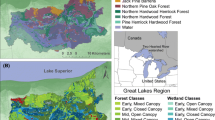Abstract
The development of U.S. national park vegetation management policies is briefly traced from 1872, when Yellowstone National Park was created, to the present. Ambiguities in legislative policies are described and partially resolved. Alternative vegetation management objectives, consistent with those policies, are evaluated using quantitative data from a giant sequoia-mixed-conifer forest community in Kings Canyon National Park. It is concluded from an analysis of this data that structural maintenance objectives are biologically infeasible in this forest community because the community does not have a fully regulated or steady-state distribution of aggregation types. Since such a steady-state distribution of aggregation types is probably not present in most forest communities, the Park Service is generally restricted to pursuing process maintenance objectives for vegetation within national parks and monuments. It is also pointed out that implementation of some process maintenance objectives is complicated by the need to return the forest community to its pre-fire exclusion state before reintroducing fire to the ecosystem. To do otherwise would perpetuate the changes in species composition and structure that have resulted from more than three-quarters of a century of fire exclusion. A new alternative for managing vegetation in national parks that is based on a high resolution description of the presettlement forest community, called the reconstruction-simulation approach, is also presented.
Similar content being viewed by others
Literature cited
Agee, J. K. 1977. Fire management in the national parks.Western Wildlands 4: 79–85.
Bonnicksen, T. M., and E. C. Stone. 1978. An analysis of vegetation management to restore the structure and function of presettlement giant sequoia-mixed conifer forest mosaics. Report to the U.S. National Park Service Western Regional Office. 159 pp.
Bonnicksen, T. M., and E. C. Stone. 1981. The giant sequoiamixed conifer forest community characterized through pattern analysis as a mosaic of aggregations.Forest Ecology and Management 3 (4): 307–328.
Bonnicksen, T. M., and E. C. Stone. 1982. The reconstruction of a presettlement giant sequoia-mixed conifer forest community using the aggregation approach.Ecology (In press). 30 pp.
Botkin, D. B., J. F. Janak, and J. R. Wallis. 1972. Rationale, limitations, and assumptions of a northeastern forest growth simulator.IBM Journal of Research Development 16 (2): 101–116.
Clar, R. C. 1969. California government and forestry—II. California Division of Forestry, Sacramento. 319 pp.
Dolan, R., and B. Hayden. 1974. Adjusting to nature in our national seashores.National Parks and Conservation Magazine 48:9–14.
Dunning, D., and L. H. Reineke. 1933. Preliminary yield tables for second-growth stands in the California pine region. USDA Technical Bulletin No. 354. Washington, DC. 24 pp.
Everhart, W. C. 1972. The National Park Service. Praeger Publishers, New York, NY. 276 pp.
Ise, J. 1961. Our national park policy: A critical history. Johns Hopkins Press, Baltimore, MD. 701 pp.
Kilgore, B. M., and D. Taylor. 1979. Fire history of a sequoiamixed conifer forest.Ecology 60: 129–142.
Leopold, A. S., S. A. Cain, C. M. Cottom, J. N. Gabrielson, and T. L. Kimball. 1963. Wildlife management in the national parks.American Forests 69: 32–35, 61–63.
Lundgren, A. L., and W. A. Dolid, 1970. Biological growth functions describe published site index curves for Lake States timber species. USDA Forest Service North Central Forest and Range Experiment Station. 9 pp.
National Academy of Sciences. 1963. A report by the Advisory Committee to the National Park Service on Research. National Academy of Sciences—National Research Council. Washington, DC. 156 pp.
Stone, E. C. 1965. Preserving vegetation in parks and wilderness.Science 150: 1261–1267.
Sumner, L. 1967. Biological research and management in the National Park Service—a history. USNPS office of Natural Sciences. (Processed). 27 pp.
U.S. National Park Service. 1968. Compilation of the administrative policies for the national parks and national monuments of scientific significance (natural area category). Washington. DC. 66 pp.
U. S. National Park Service. 1978. Management policies. Washington, DC. 156 pp.
Wright, G. M., J. S. Dixon, and B. H. Thompson. 1933. A preliminary survey of faunal relations in national parks. USDI National Park Service Fauna Series No. 1. 157 pp.
Author information
Authors and Affiliations
Rights and permissions
About this article
Cite this article
Bonnicksen, T.M., Stone, E.C. Managing vegetation within U.S. national parks: A policy analysis. Environmental Management 6, 109–122 (1982). https://doi.org/10.1007/BF01871431
Issue Date:
DOI: https://doi.org/10.1007/BF01871431




